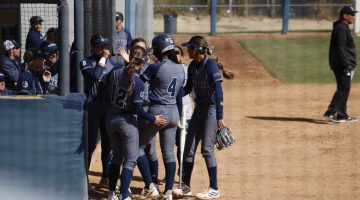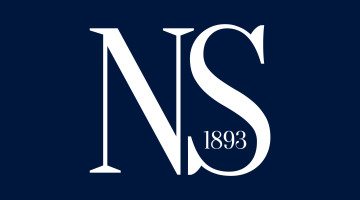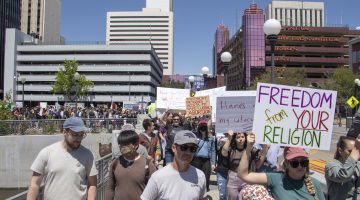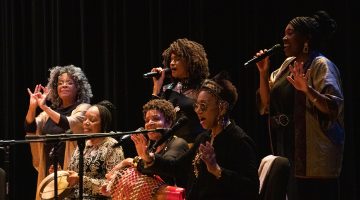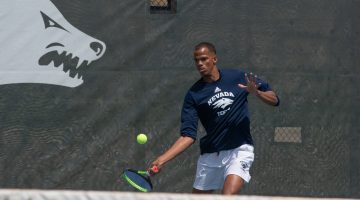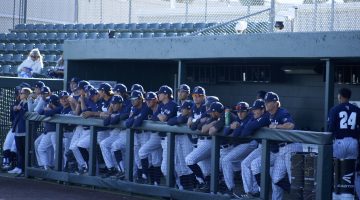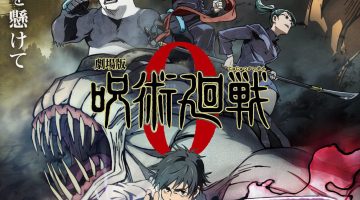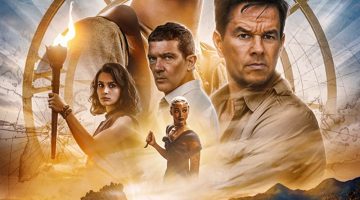The lights dim and a heavy stillness falls on the audience. Then, eight performers step out from the darkness, their french horns in tow.
They line up, take off their masks and shatter the silence in a matter of seconds.
This highly emotional scene was part of the Horn Ensemble and Trumpet Ensemble Double Header Concert, held on Nov. 15 at the Harlan O. and Barbara R. Hall Recital Hall.
The concert consisted of performances from two troupes. First was an all-horn ensemble led by Natalie B. Higgins, UNR’s assistant horn professor, and second was an all-trumpet ensemble led by Jonathan Bhatia, a lecturer with a master’s degree in music.
For many of the 19 young musicians across two groups, this was their first performance in almost three years.
In such a tightly controlled space as the Hall Recital Hall, there was to be no corner of the room untouched by the brilliantly loud ravish of the performers’ instruments.
“I know that this isn’t your first all-brass concert,“ Bhatia joked to the audience, “because none of you are sitting in the front row.”
Higgin’s horn ensemble opened their 30-minute set with a rendition of Queen’s “Bohemian Rhapsody.”
Joshua Anderson’s piano accompaniment guided the excited eight-piece group. The performers took turns belting out Freddie Mercury’s enduring melody.
The bombastic arrangement added a much-needed layer of regality to the seventies rock centerpiece, held back only by the original’s blunt stadium sensibilities.
Regardless, the audience was hooked from the very first note.
Jason Frogget introduced his solo performance of “Waltzing Matilda” with a reduced section of three players. Though the background performers were dominant at times, Frogget’s charmingly gruff intonation commanded the audience’s attention.
The entire ensemble then quickly reconvened for Michael Jackson’s “Thriller.” The iconic chorus, played in perfect unison, turned the stage into a platform of sound which shook the small performance hall to its core.
As Higgin’s group quickly began to reach the end of their portion, the performers’ energy remained consistent.
Admittedly, however, the subdued sound of their horns alone had begun to sound stale.
Their last performance, an original composition, made by Kerry Turner and titled “Farewell to Red Castle”, thankfully rectified this concern and made for an overall strong finish.
In a development from previous setups, the performers played with mutes and stockhorns to bring extra depth to their modern medieval medley. These adjustments, though appearing cosmetic at first, made the piece cinematic.
A ten minute intermission placed a thematic wedge between the two ensembles, but it offered a moment for the audience to appreciate the performers’ rapturous energy.
After the intermission, the audience watched as the trumpet ensemble entered and immediately formed in an orderly, C-shaped line.
It was clear from this moment forward the trumpeteers would treat this space as seriously as their french horn counterparts.
Bhatia commenced his ensemble’s set with “Fanfare” from the 1912 French opera “La Péri.” Though this particular extract was deeply ornate and featured multiple intricate parts, the performers moved as a collective musical entity.
This promising sense of unity was explored further in “Cityscapes”, an Erik Morales-composed chamber piece which consisted of a reduced ensemble, three distinctive movements and a runtime of 11 minutes.
The highly modern composition buzzed with the hustle and bustle of a crowded Wall Street sidewalk, thousands of miles away from the solitude-stricken west coast.
Taking a page from the Horn ensemble’s creative rulebook, the five performers occasionally used their horns as percussive proxy instruments, rhythmically pattering the mouthpieces with their hands and creating a unique, unforgettable popping noise.
Breaking the pattern of more austere pieces, first-year graduate student Rob Smith introduced the New Orleans-inspired “Bourbon Street Breakdown.”
Soloist Alex Hawvichorst treated the audience with a beautifully blustering improvisation, loud and proud, just like the rest of the foot-tapper.
The falling action of the evening was something to behold, along with the all-trumpet group.
Cherishing love and beauty in the face of death, the performance of “It Thou Be Near” proved Bach’s musical toolbook works universally—both between generations and across instruments, including those of the harsher variety.
The same easily describes “The New Century”, which performer Casey Smith prefaced as a tune which gets weird the longer it goes on.
In reality, the ensemble’s skill and togetherness made the song’s many moving parts work effortlessly.
After 40 minutes of fanfare, the concert concluded with “Infinite Ascent,” another tune from “Cityscapes” composer Morales.
Bhatia prefaced the finale by sharing its connection to the legendary 1956 French short film “The Red Balloon”. It’s a relevant selection to the occasion at hand, as the performers embraced their triumphant return to an organized concert environment.
But like any other long-overdue homecoming, this ascension carried the solemn weight of maturity following a time of great crisis and turmoil.
As the trumpets rang out into the soulful abyss, it became clear the solitude of a brass-only musical menagerie had done more to grant the performers their strength than to limit it in an otherwise unfocused and multi-faceted world.
This piece was a lot more solemn and bittersweet in the ascension, but it still met the beauty of the fanfare.
Wyatt Layland can be reached at jaedynyoung@sagebrush.unr.edu or on Twitter @NevadaSagebrush.


